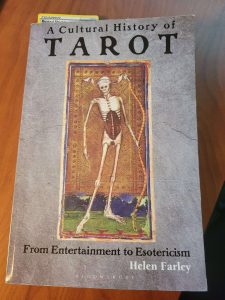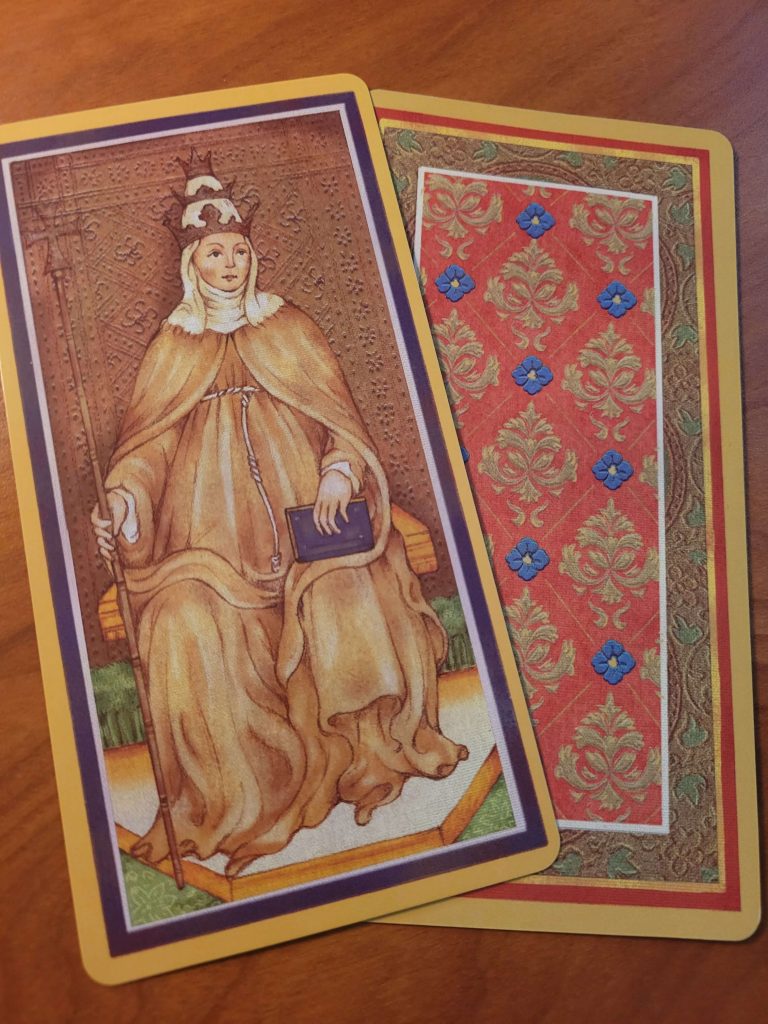I was recently gifted the Golden Tarot which a family friend came across in a used book store. I was thrilled because this deck is a re-creation of the second oldest known deck, the Visconti-Sforza deck. The oldest surviving deck was likely created sometime between 1414-1418 in Milan, Italy by the Duke Filippo Maria Visconti. Helen Farley outlines how the major arcana was originally a trump sequence for a card game and was designed to reflect the Duke’s life.

The Visconti-Sforza deck was a later revision of this original deck after his daughter’s marriage to Francesco Sforza. The crest of both houses appear in the minor arcana of these cards. Farley’s book , A Cultural History of Tarot, has been a fascinating look into both the history of the deck’s creation and how it became a divinatory tool in esoteric circles.
Farley outlines the deeply Catholic symbolism in the decks along with the criticism of the early church. I will likely take a deep dive into some of those stories as I work my way through the book and the deck, but for this post, I want to share my favorite story which is the existence of the Popess card from this deck. This card would eventually become the High Priestess in later decks.

A religious woman, and possible Bohemian princess, named Guglielma arrived in Milan and lived alone except for her followers. She was known to be pious, was generous with her charity, and spoke about a feminized church. I was hoping to learn a little more about her, but haven’t been able to locate more detail about what that charity might have been or what she had to say about a feminized church. Presumably because the Dominican’s burned the writings of both Guglielma and her disciples.
During her life, she had a follower named Sister Maifreda who continued the sect after Gugliema’s death and claimed that they were destined to found a new church led by women to replace the corrupt establishment. Sister Maifreda soon drew the attention of the Inquisition and was burned at the stake as a heretic. Her sect continued, and in 1420 and the tradition continued at the nunnery of San Andrea.
So how does this connect to the Visconti-Sforza deck? Sister Maifreda was a first cousin to Duke Filippo Maria Visconti’s father and was considered a family martyr. Bianca Maria Visconti, the Duke’s daughter and Sforza’s wife, was an admirer of both women. She patronized their nunnery which subsequently became a church and houses a portrait of the two women. Farley theorizes that Sister Maifreda and the portrait from this church are the inspiration for the Popess card in this deck.
I think I was so fascinated by this story because of the existence of a feminist religious sect in the early days of the Catholic church. My feminist ideals were the main reason I found myself at odds with my religious upbringing and so the existence of feminism in the early church kind of blew my mind. I still can’t reconcile current church teachings on sexuality and reproductive rights with my experience as a woman, but I’m grateful for the knowledge that I’ve found in this book.

